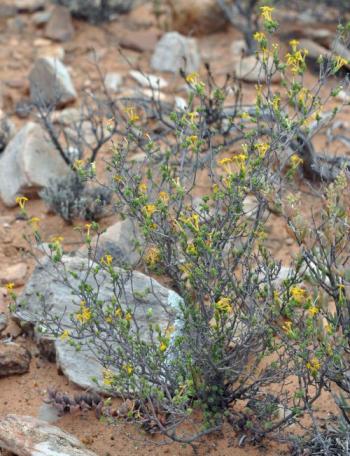Lasiosiphon deserticola
Lasiosiphon deserticola (Gilg) C.H.Wright
Family: Thymelaeaceae
Common names: saffron curryflower (Eng.); saffraan, saffraanbos, verfbossie, hotnotsverfbossie (Afr.)
Introduction
An evergreen shrub with bright, ochre-yellow, night-scented flowers, which can be used to make a yellow dye.

Description
Description
Twiggy, evergreen shrub, 0.5 to 1.0 m tall. The leaves are alternate or sub-opposite, overlapping one another closely and clustered at the tips of the branches, slightly leathery in texture and hairless to hairy. The night-scented, waxy, ochre-yellow flowers have a hairy tube, 5 petaloid sepals and lacks scales (petals reduced to scale-like appendages in this family). The flowers are borne in small terminal clusters with 3 or rarely up to 6 flowers. Flowering occurs in winter and spring, from June to October.

Conservation Status
Status
According to the Red List of South African plants, the conservation status of this species is assessed as Least Concern (LC).
Distribution and habitat
Distribution description
Lasiosiphon deserticola is restricted to the winter rainfall region of the Western Cape where it occurs on dry flats or lower slopes from the Cederberg mountains to Worcester and east through the Little Karoo.

Derivation of name and historical aspects
History
The generic name Lasiosiphon is derived from the Greek words lasio, meaning ‘woolly’ and siphon, meaning ‘tube’ and refers to the hairy floral tubes in several of the species. The specific epithet deserticola meaning ‘dweller in deserts’ refers to the arid areas in which it is found.

Ecology
Ecology
Unlike several other members of the genus which are poisonous, Lasiosiphon deserticola is highly palatable and so readily browsed by livestock and game. According to Vlok & Schutte-Vlok (2010) the plants are re-seeders and so do not resprout after fire. The ochre-yellow flowers are sweetly scented at night and so likely moth pollinated.
Lasiosiphon deserticola has previously been confused with an undescribed species from the Upper Karoo Region of South Africa. The 2 species are superficially very similar but differ in the presence or absence of floral scales (present in the new species) and the number of flowers (5 to 8 per cluster in the new species) (Kolokoto in prep.).
Uses
Use
The flowers of Lasiosiphon deserticola were used by Khoi Khoi people to make a permanent yellow dye for leather. The English naturalist Burchell during his extensive travels in South Africa, 1811 to 1815, made a yellow pigment from the dried flowers of L. deserticola which he used in his paintings.

Growing Lasiosiphon deserticola
Grow
Lasiosiphon deserticola is best suited to dry areas in Mediterranean climate gardens, such as the winter rainfall areas of the Western and Northern Cape Provinces (see also Lasiosiphon rigidus). This striking shrublet should be planted in a sunny well drained position near the front or middle of a garden bed. It would do well in a rockery or as a container subject where the night scented flowers can be appreciated. Tip pruning will encourage compact growth and even flowering and so increasing its attractiveness as a garden ornamental. Lasiosiphon deserticola can be propagated from tip cuttings treated with a rooting hormone or from seeds sown in autumn.
References
- Manning, J. 2009. Field guide to wild flowers of South Africa. Struik Nature, Cape Town.
- Manning, J, & Goldblatt, P. 1996. West Coast. South African Wild Flower Guide 7. Botanical Society of South Africa, Cape Town
- Shearing, D. 1994. Karoo. South African Wild Flower Guide 6. Botanical Society of South Africa. Claremont.
- von Staden, L. 2015. Lasiosiphon deserticola (Gilg) C.H.Wright. National Assessment: Red List of South African Plants version 2017.1. Accessed on 2019/09/30
- Kolokoto, R. & Makhoba T. 2017. Lasiosiphon rigidus J.C.Manning & Boatwr. (Thymelaeaceae). PlantZAfrica. Internet pp. http://pza.sanbi.org/lasiosiphon-rigidus
- Vlok, J. & Schutte-Vlok, A. 2010. Plants of the Klein Karoo. Umdaus Press, Hatfield, Pretoria.
Credits
Odwa Obose, Refilwe Kolokoto and Anthony Magee
Compton Herbarium
October 2019
Plant Attributes:
Plant Type: Shrub
SA Distribution: Western Cape
Soil type: Sandy
Flowering season: Spring, Winter
PH: Acid
Flower colour: Yellow
Aspect: Full Sun
Gardening skill: Average
Special Features:
Horticultural zones









Rate this article
Article well written and informative
Rate this plant
Is this an interesting plant?
Login to add your Comment
Back to topNot registered yet? Click here to register.